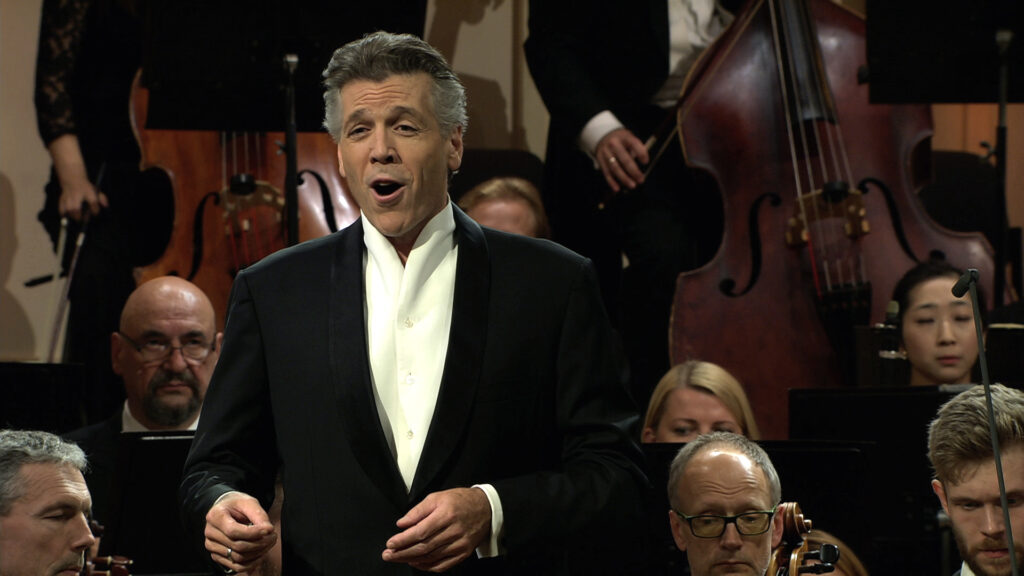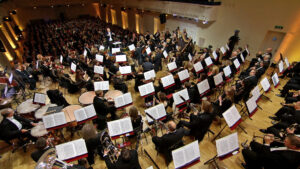Early Gustav Mahler
Synopsis
Conductor Neeme Järvi and baritone Thomas Hampson are two of the world’s leading interpreters of the music of Gustav Mahler. In this 2017 concert with the Estonian National Symphony Orchestra, Järvi and Hampson turn their attention to  Mahler’s Songs of a Wayfarer (Lieder eines fahrenden Gesellen) and the Symphony No. 1, including – as a separate piece on the program – Blumine, originally the 2nd movement of the Symphony but eliminated after the first three performances. Although these works, dating from 1884 to 1888, are among his earliest masterpieces as a composer, Mahler had already begun a meteoric ascent as an opera conductor. At his first important job as Musical and Choral Director of the Royal Theatre in Kassel, Mahler met the soprano Johanna Richter. Their difficult love affair inspired a set of poems penned by Mahler and then set to music as Songs of a Wayfarer. The First Symphony was composed during his final months as Second Kapellmeister of the Leipzig Opera. There the wife of composer Carl Maria von Weber’s grandson encouraged Mahler to compose a large-scale work.
Mahler’s Songs of a Wayfarer (Lieder eines fahrenden Gesellen) and the Symphony No. 1, including – as a separate piece on the program – Blumine, originally the 2nd movement of the Symphony but eliminated after the first three performances. Although these works, dating from 1884 to 1888, are among his earliest masterpieces as a composer, Mahler had already begun a meteoric ascent as an opera conductor. At his first important job as Musical and Choral Director of the Royal Theatre in Kassel, Mahler met the soprano Johanna Richter. Their difficult love affair inspired a set of poems penned by Mahler and then set to music as Songs of a Wayfarer. The First Symphony was composed during his final months as Second Kapellmeister of the Leipzig Opera. There the wife of composer Carl Maria von Weber’s grandson encouraged Mahler to compose a large-scale work.
Mahler drew on themes from the Wayfarer cycle for his First Symphony: the melody of the second song became the main theme of the 1st Movement of the Symphony, and the final verse of the 4th song appears in the Symphony’s 3rd Movement, where it provides a moment of repose within the funeral march. The main melody of Blumine, first played by the trumpet, can also be found in the Symphony: in the dance movement and as part of a slow passionate theme that provides contrast within the turbulent finale.
Synopsis
Conductor Neeme Järvi and baritone Thomas Hampson are two of the world’s leading interpreters of the music of Gustav Mahler. In this 2017 concert with the Estonian National Symphony Orchestra, Järvi and Hampson turn their attention to  Mahler’s Songs of a Wayfarer (Lieder eines fahrenden Gesellen) and the Symphony No. 1, including – as a separate piece on the program – Blumine, originally the 2nd movement of the Symphony but eliminated after the first three performances. Although these works, dating from 1884 to 1888, are among his earliest masterpieces as a composer, Mahler had already begun a meteoric ascent as an opera conductor. At his first important job as Musical and Choral Director of the Royal Theatre in Kassel, Mahler met the soprano Johanna Richter. Their difficult love affair inspired a set of poems penned by Mahler and then set to music as Songs of a Wayfarer. The First Symphony was composed during his final months as Second Kapellmeister of the Leipzig Opera. There the wife of composer Carl Maria von Weber’s grandson encouraged Mahler to compose a large-scale work.
Mahler’s Songs of a Wayfarer (Lieder eines fahrenden Gesellen) and the Symphony No. 1, including – as a separate piece on the program – Blumine, originally the 2nd movement of the Symphony but eliminated after the first three performances. Although these works, dating from 1884 to 1888, are among his earliest masterpieces as a composer, Mahler had already begun a meteoric ascent as an opera conductor. At his first important job as Musical and Choral Director of the Royal Theatre in Kassel, Mahler met the soprano Johanna Richter. Their difficult love affair inspired a set of poems penned by Mahler and then set to music as Songs of a Wayfarer. The First Symphony was composed during his final months as Second Kapellmeister of the Leipzig Opera. There the wife of composer Carl Maria von Weber’s grandson encouraged Mahler to compose a large-scale work.
Mahler drew on themes from the Wayfarer cycle for his First Symphony: the melody of the second song became the main theme of the 1st Movement of the Symphony, and the final verse of the 4th song appears in the Symphony’s 3rd Movement, where it provides a moment of repose within the funeral march. The main melody of Blumine, first played by the trumpet, can also be found in the Symphony: in the dance movement and as part of a slow passionate theme that provides contrast within the turbulent finale.
Synopsis
Conductor Neeme Järvi and baritone Thomas Hampson are two of the world’s leading interpreters of the music of Gustav Mahler. In this 2017 concert with the Estonian National Symphony Orchestra, Järvi and Hampson turn their attention to Mahler’s Songs of a Wayfarer (Lieder eines fahrenden Gesellen) and the Symphony No. 1, including – as a separate piece on the program – Blumine, originally the 2nd movement of the Symphony but eliminated after the first three performances. Although these works, dating from 1884 to 1888, are among his earliest masterpieces as a composer, Mahler had already begun a meteoric ascent as an opera conductor. At his first important job as Musical and Choral Director of the Royal Theatre in Kassel, Mahler met the soprano Johanna Richter. Their difficult love affair inspired a set of poems penned by Mahler and then set to music as Songs of a Wayfarer. The First Symphony was composed during his final months as Second Kapellmeister of the Leipzig Opera. There the wife of composer Carl Maria von Weber’s grandson encouraged Mahler to compose a large-scale work.

Mahler drew on themes from the Wayfarer cycle for his First Symphony: the melody of the second song became the main theme of the 1st Movement of the Symphony, and the final verse of the 4th song appears in the Symphony’s 3rd Movement, where it provides a moment of repose within the funeral march. The main melody of Blumine, first played by the trumpet, can also be found in the Symphony: in the dance movement and as part of a slow passionate theme that provides contrast within the turbulent finale.
Artists
Thomas Hampson
Neeme Järvi
Estonian National Symphony Orchestra
Thomas Hampson
Neeme Järvi
Estonian National Symphony Orchestra
Trailer
